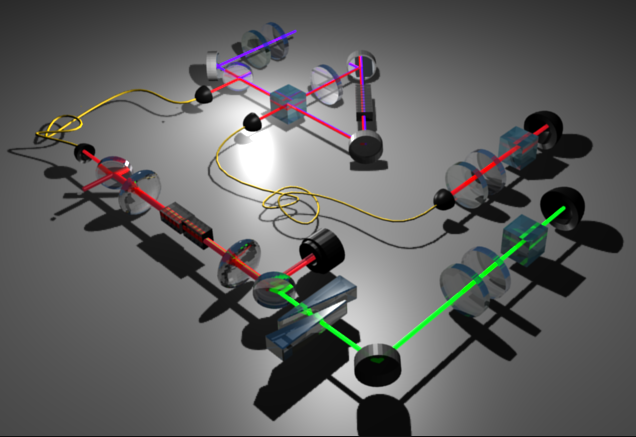Photonic ups and downs
- Post by: admin
- April 2, 2012
- 4 Comments
The photons I work with have experienced a roller coaster lately, having been down-converted here and now up-converted in a new paper we just published in PRA. This time, the photons didn’t have to go their own way though. They were assisted in their journey from higher (810 nm) to lower wavelengths (532 nm) by a strong telecom seed laser. This wouldn’t be big news though, as many other groups have previously reported this so-called sum-frequency generation between single photons and strong seed lasers. The actual news is that we have managed to up-convert polarization-entangled photons.

We started by generating polarization-entangled photon pairs at 820 nm, mixed them with a strong 1550 nm laser and sent them through the reverse version of Paul Kwiat’s sandwich source: two nonlinear crystals quasi-phase-matched for type-I up-conversion of 820+1550->532 nm, with orthogonal orientations. The overall efficiency of the up-conversion scheme was atrocious, but it precisely matched theoretical expectations for our scheme, given the available pump power and limitations in geometry an optical loss. More importantly, the entanglement between the up-converted green photons and their original 820 nm partners was almost perfect.
Our results show for only the second time (the first being Nicolas Gisin’s fabulous time-bin entanglement up-conversion experiment) that entanglement is preserved in a sum-frequency experiment with a strong seed laser. As we argued in our paper, this type of coherent interconversion between wavelengths will be an important tool in the larger picture of practical quantum information processing. Nature Photonics included our paper in their March 2012 research highlights.
Awesome results! ^_^
Hi!
Nice experimental scheme. I would like to know which editor did you use to make such a nice drawing!
Thanks for your help…
Luis
Thanks! I created that using the open source 3D renderer Blender, available at http://www.blender.org